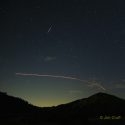Sonora, CA – NASA scientists say the early hours Wednesday should be the peak time to see this year’s Perseids meteors on full display. Read on to hear about and view local images…
As we reported last week here in detail, this celestial event, which occurs every year from mid-July through mid-August, is known for its number and intensity of explosive light activity, aka “fireballs.” It is easily viewable in the Northern Hemisphere with the naked eye, as no doubt, many folks noticed over the weekend.
NASA astronomers say the most active time for this year’s showers should come between 2 a.m. and dawn local time Wednesday, although midnight to dawn any morning this week, and next it will still be possible to see shower activity barring cloud cover. They stress the importance of finding a dark place to look overhead to the north and take about 30 minutes to allow your eyes to adjust to the night sky.
Local photographer and astronomy buff Jim Cruff confirms that cloud cover over the past few nights has created a bit of a viewing challenge. He shares a long-exposure photo taken just after sunset Monday night near New Melones reservoir, which caught a Perseid meteor while a CalFire helicopter traveled below, creating a red dotted line. He also created a 20-second video by merging 359 photos you can view by clicking the link in the image box.
Our astronomy photo gallery can be seen by clicking here
To share local images, email them to news@clarkebroadcasting.com


